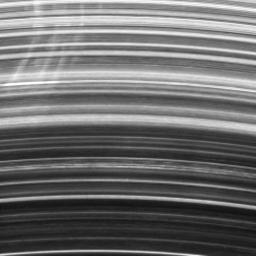
|
The Spoke Search
- Click the image above for a larger view
- Full-Res JPEG (504 x 504) (31.5 kB)
- Full-Res TIFF (504 x 504) (254.5 kB)
Caption:
A group of bright spokes tightly cluster together in Saturn's B ring. The spokes seen here generally all exhibit the same degree of shearing, or tilting, but some deviations are apparent. In this image, the direction to Saturn is downward; orbital motion is to the left.
Ring scientists are eager for data to help them understand and eventually explain how these mysterious ring features are created. To that end, Cassini has been directed to acquire movie sequences, like the one this image is part of, that watch for these elusive radial structures.
This observation focused on the morning side of the rings, the side where the rings are rotating out from Saturn's shadow. Spokes appear most frequently at this location.
Also barely visible in this image are broader, much fainter but still bright radial regions that extend over larger radial distances than the spokes in the upper left. Where these fainter features cross ringlets in the lower part of the image, slight variations in brightness are apparent. These are probably due to tiny particles, possibly part of a former spoke, that haven't yet settled down onto the ring plane.
Although their formation is still a subject of inquiry, scientists are confident that the microscopic spoke particles are slightly electrically charged and therefore are influenced by Saturn's magnetic field.
The brightness of the spokes, when combined with viewing geometry information and estimates of their particle sizes can help researchers determine the amount of material in the spokes--a crucial quantity to constrain theories of spoke formation.
The image was taken in visible light with the Cassini spacecraft narrow-angle camera on Sept. 28, 2006, at a distance of approximately 1.3 million kilometers (800,000 miles) from Saturn and at a Sun-Saturn-spacecraft, or phase, angle of 147 degrees. Scale in the original image was about 32 kilometers (20 miles) per pixel. The view has been magnified by a factor of two.
Background Info:
The Cassini-Huygens mission is a cooperative project of NASA, the European Space Agency and the Italian Space Agency. The Jet Propulsion Laboratory, a division of the California Institute of Technology in Pasadena, manages the mission for NASA's Science Mission Directorate, Washington, D.C. The Cassini orbiter and its two onboard cameras were designed, developed and assembled at JPL. The imaging operations center is based at the Space Science Institute in Boulder, Colo.
For more information about the Cassini-Huygens mission visit http://saturn.jpl.nasa.gov/home/index.cfm . The Cassini imaging team homepage is at http://ciclops.org .
Cataloging Keywords:
| Name | Value | Additional Values |
|---|---|---|
| Target | Saturn Rings | B Ring, Saturn |
| System | Saturn | |
| Target Type | Ring | Planet |
| Mission | Cassini-Huygens | |
| Instrument Host | Cassini Orbiter | |
| Host Type | Orbiter | |
| Instrument | Imaging Science Subsystem (ISS) | |
| Detector | Narrow Angle Camera | |
| Extra Keywords | Grayscale, Magnetosphere, Rotation, Shadow, Visual | |
| Acquisition Date | ||
| Release Date | 2006-10-05 | |
| Date in Caption | ||
| Image Credit | NASA/JPL/Space Science Institute | |
| Source | photojournal.jpl.nasa.gov/catalog/PIA08288 | |
| Identifier | PIA08288 | |
